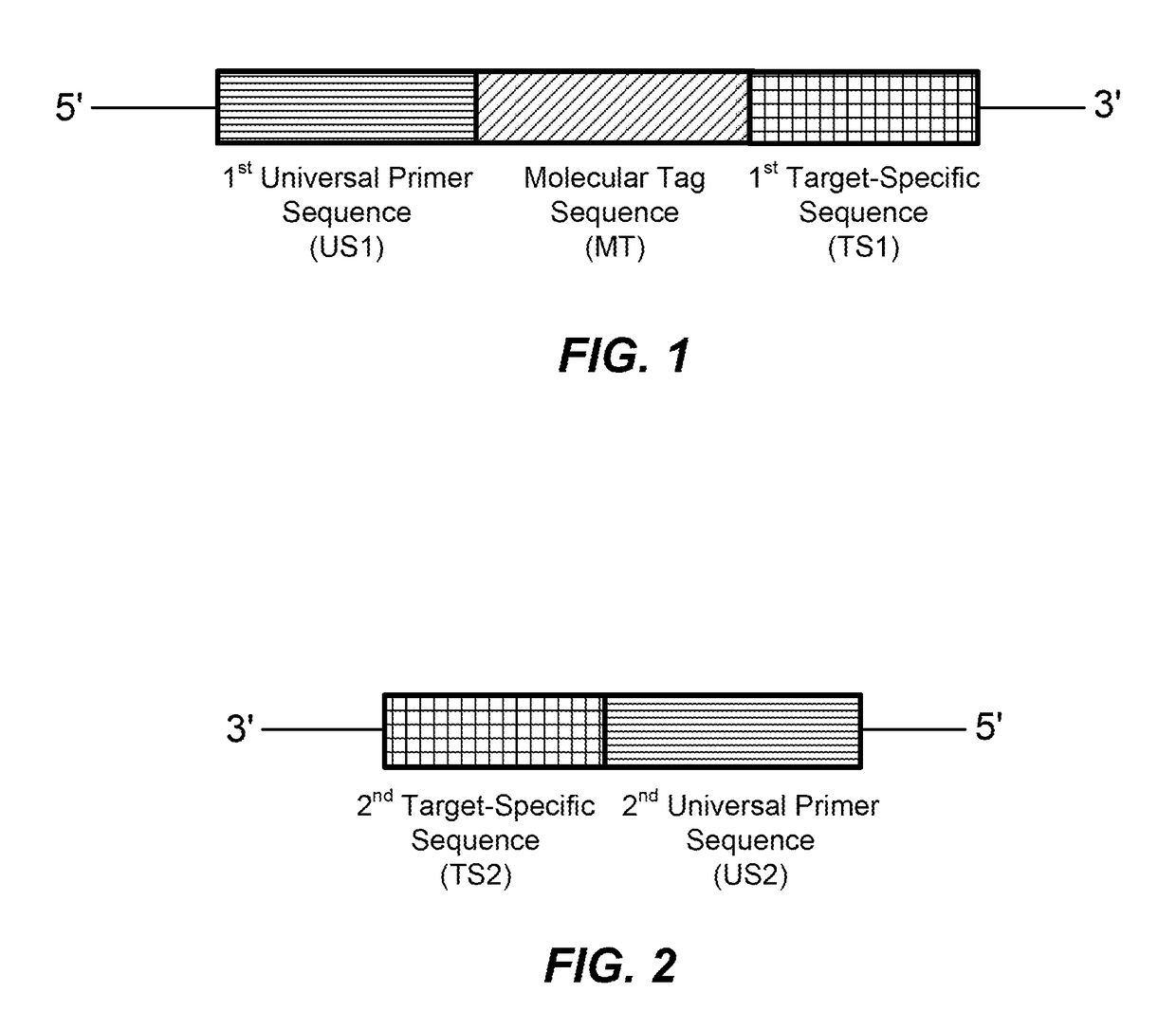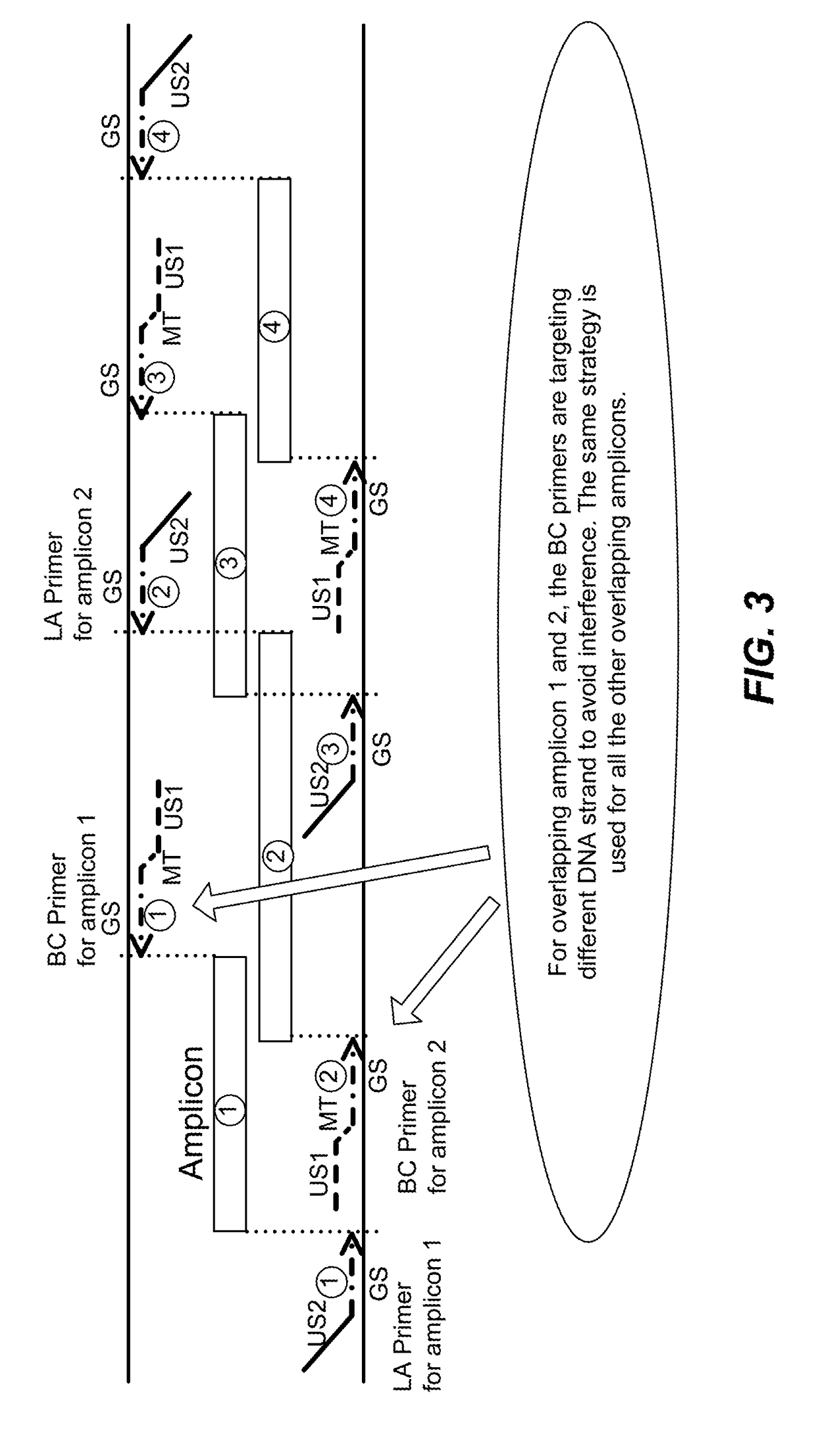High multiplex PCR with molecular barcoding
a technology of molecular barcodes and multiplex pcr, which is applied in the direction of microbiological testing/measurement, biochemistry apparatus and processes, etc., can solve the problems of insufficient coverage of low abundant transcripts, significant pcr amplification bias, and introduction of substantial bias (non-uniform amplification)
- Summary
- Abstract
- Description
- Claims
- Application Information
AI Technical Summary
Benefits of technology
Problems solved by technology
Method used
Image
Examples
example 1
Detecting SNVs at Very Low Allelic Frequencies
Preparation of In Vitro “Genome in a Bottle” Sample Mixtures
[0142]Human genomic DNA samples of NA12878 and NA19129 were purchased from Coriell Institute. Sample mixture was created based on the actual amplifiable DNA in each sample, resulting in 2% of NA12878 DNA mixed in the NA19129 DNA. The resulting DNA mixture contains NA12878 variants present at 1-2% fraction. Homozygous SNVs unique for NA12878 are at 2% in the mixture, while heterozygous SNVs are at 1%. Most of the 134 variants from NA12878 are heterozygous SNVs.
380 Amplicon Panel Description
[0143]Primers were generated to target approximately 39 kb region in human genome. Primer pairs were selected based on optimal primer Tm, GC content, uniqueness of the primer sequence in human genome, low probability to form primer dimer and self-dimer, and collectively the ability to cover as many target regions as possible. Half of the primers were designed to cover 134 high-confidence SNVs f...
example 2
Preparing Sequencing Library with Low Amount of Genomic DNA
934 Amplicon Panel Description
[0154]Additional 554 amplicons were designed using the same primer design algorithm as the 380 amplicon panel of Example 1, to cover all protein coding regions of another 12 genes: KRAS, TP53, AKT1, ATM, BRAF, FBXW7, PIK3CA, EGFR, ALK, NRAS, BAX and TGFBR2. Those primers were combined with the primers from 380-amplicon panel, resulting in the 934-amplicon panel. The combined panel covers a target region of approximately 87 kb.
934 Amplicon Panel Enrichment Protocol
[0155]1 ng human genomic DNA was mixed with 20 nM each BC primer, KOD DNA polymerase and reaction buffer (Toyobo, Japan). The following barcode assignment conditions were used: 98° C. for 2 min, 55° C. for 15 min, 65° C. for 15 min, and 72° C. for 7 min. To ensure complete removal of excess BC primers, each sample was purified two rounds using GeneRead Size Selection Kit. The purified DNA was then mixed in 25 ul with 20 nM each LA prime...
example 3
Measuring Low Abundant RNA Transcripts
ERCC RNA Amplicon Enrichment Protocol
[0157]ERCC RNA Spike-in Control Mix 1 was purchased from Life Technologies (Carlsbad, Calif.). It was further diluted 1:100 in the background of human normal universal RNA (BioChain, CA). 10 ng total RNA containing the ERCC RNA were reverse transcribed into cDNA using QuantiTect Reverse Transcription kit (QIAGEN, Germany). One fifth of the cDNA was used in the barcode assignment step together with 2 nM each BC primer, 16 mM Mg2+, 6U HotStarTaq and 1× miScript preamp buffer. The following barcode assignment conditions were used: 95° C. for 15 min, 55° C. for 15 min, 65° C. for 15 min, and 72° C. for 7 min. To ensure complete removal of excess BC primers, reaction was purified in two rounds using GeneRead Size Selection Kit. The purified DNA was then mixed in 25 ul with 2 nM each non-BC primer, 4 mM Mg2+, 0.45 mM dNTP, 6U HotStarTaq and 1× miScript preamp buffer. The reaction was continued at following conditio...
PUM
| Property | Measurement | Unit |
|---|---|---|
| Fraction | aaaaa | aaaaa |
| Fraction | aaaaa | aaaaa |
| Mass | aaaaa | aaaaa |
Abstract
Description
Claims
Application Information
 Login to View More
Login to View More - R&D
- Intellectual Property
- Life Sciences
- Materials
- Tech Scout
- Unparalleled Data Quality
- Higher Quality Content
- 60% Fewer Hallucinations
Browse by: Latest US Patents, China's latest patents, Technical Efficacy Thesaurus, Application Domain, Technology Topic, Popular Technical Reports.
© 2025 PatSnap. All rights reserved.Legal|Privacy policy|Modern Slavery Act Transparency Statement|Sitemap|About US| Contact US: help@patsnap.com



